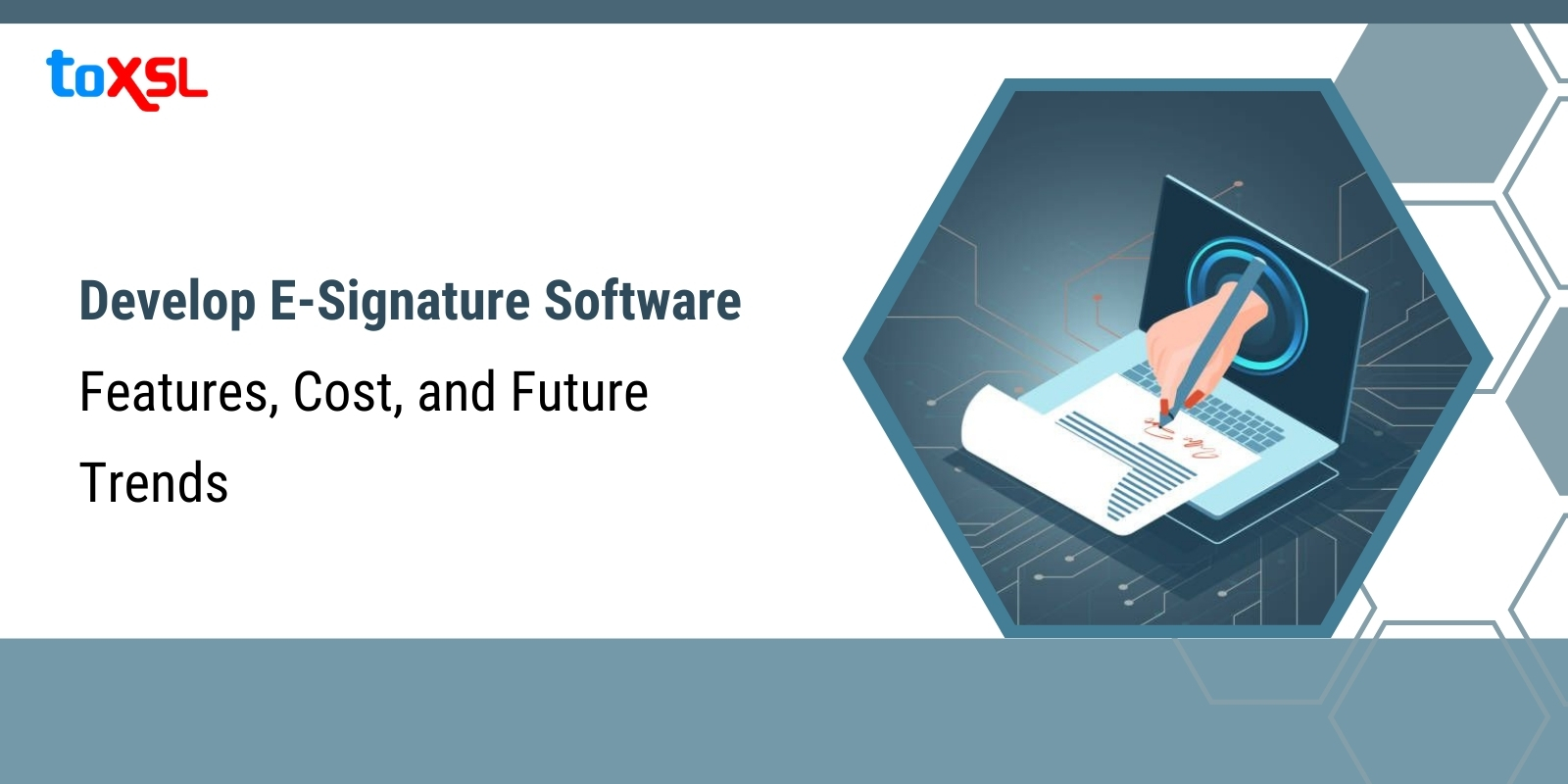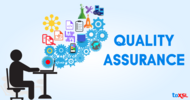- Sep 09, 2025
Share this post on:

Did you know e-signature software helped 82% of businesses enhance ROI within a year? E-signatures are increasingly transforming businesses, enhancing the adoption of digital signatures globally. These software solutions allow users to sign documents electronically, replacing traditional methods of printing and scanning paper. The solution makes it easier to manage workflows and keeps signed documents safe.
It also allows you to get signed documents quickly from anywhere without any hassle. So, if you want to create e-signature software to help your business run better, you can get help from a software development company. With the right skills from a software development company, you can create easy-to-use and secure e-signature software that fits your business needs.
Let’s look at the statistics:
By 2023, the global digital signature market was expected to be worth $7.5 billion. It is now projected to grow to $10.0 billion by the end of 2024.
The e-signature industry is predicted to grow at a rate of 33.5% each year, reaching about $134.9 billion by 2033.
According to Statista, the market for digital signatures is estimated to increase from $3.9 billion in 2022 to approximately $43.14 billion by 2030.
The digital signature market is expanding rapidly due to the increasing need for secure and legally recognized electronic transactions across various sectors, including banking, healthcare, and government. Digital signatures use advanced technology to ensure that documents are authentic and have not been changed during transmission.
Factors driving the growth of digital signatures include:
The rise of e-commerce and online transactions.
Government regulations that recognize digital signatures as valid.
The growing demand for paperless processes and efficient document management.
Step-by-step process to develop e-signature software
Developing e-signature software is a challenging process; it involves various steps that businesses must know.
Research and Planning
Do you know what is new in the market? Have you done a proper analysis on your competitors? What are they offering, and what can you do to make your software stand out? This phase is important to set the strong foundation for creating e-signature software.
At first, do proper research on your target users and their specific requirements. With that, try to understand what new users are expecting to get from the new software, helping you to define the main features and functionalities of the software.
Now, once the research and planning process is completed, it's time to analyze the performance of your competitor's applications. This will help you understand their strengths and weaknesses. And, knowing this, you can stand out and come up with a unique mobile app in the market.
Choosing the right tech stack
One of the most crucial steps in developing an e-signature app is choosing the right tech stack. It impacts the performance and scalability of the application and helps you choose the correct technologies for the platform (Android, iOS, or the web).
But how do you decide the tech stack? Well, it depends on the features and functionalities that you want to incorporate in your software.
For backend development, the most common tech stack used is Python, Node.js, and Java.
For the frontend, consider React, Vue.js, or Angular to develop an interactive user interface.
Among all these, security plays a vital role. Hence, it is better to choose encryption technologies, third-party integrations such as cloud, and secure communication protocols such as SSL/TLS.
User-friendly Interface
A user-friendly interface is one of the most important features in e-signature development. A well-designed interface ensures that users can navigate through the application.
Start the development process by designing prototypes and wireframes to visualize the flow and layout of the software. Businesses must focus on the simplicity and intuitiveness of the app. Ensure that you keep all the instructions clear and straightforward, with minimum distraction.
Features Development
After designing comes the development part. The process starts by creating pre-defined features, including:
Features in E-Signature Software
1. Digital Signature Creation
Allows users to create secure, legally binding digital signatures for documents. Ensures authenticity and integrity of signed content.
2. Document Upload and Management
Enables easy uploading, storing, organizing, and tracking of documents within the platform. Streamlines the signing workflow.
3. Multi-Factor Authentication
Adds an extra layer of security by requiring multiple verification steps. Prevents unauthorized access to sensitive documents.
4. Audit Trails and Logs
Automatically records every action taken on a document. Provides full transparency and legal proof of document handling.
5. Real-Time Notifications
Sends instant alerts about document status, such as viewed, signed, or pending. Keeps all parties updated without delays.
6. Role-Based Access Control
Restricts document access and actions based on user roles. Ensures only authorized users can view or modify documents.
7. Third-Party Integrations (CRM, Cloud, APIs)
Connects with other tools like CRMs, cloud storage, and APIs. Enhances workflow by enabling seamless data sharing and automation.
8. Offline Signing Capability
Allows users to sign documents without an internet connection. Syncs changes automatically once back online.
9. Mobile and Web Accessibility
Provides access to sign and manage documents via mobile devices and web browsers. Supports flexible and remote usage.
10. Compliance with eIDAS, ESIGN, UETA, HIPAA
Meets global legal and security standards for digital signatures. Ensures compliance in industries like healthcare, finance, and government.
E-signatures allow users to sign the documents electronically and let them upload, organize, and store the document safely.
Ensure that you incorporate features such as multi-factor authentication for security and integrate APIs for seamless connectivity with third-party applications, including cloud storage services and CRM systems.
Security and Compliance
Security is essential when it comes to any app. Hence, implement strong security protocols such as SSL/TLS. Make sure the software complies with standards for legal validity.
Include audit trails to track document history and modifications.
Testing and Quality Assurance
The testing phase ensures that e-signature software works well and can grow with demand.
Unit Testing: Ensures each part works well individually.
Integration Testing: Verifies that different parts work together.
User Acceptance Testing (UAT): Real users test for usability issues.
Security Testing: Identifies vulnerabilities and strengthens defenses.
Automated Testing Tools: Speeds up and standardizes testing.
Regression Testing: Confirms new changes don’t harm existing features.
Thorough testing identifies issues early, leading to a more reliable solution.
Deployment Phase
Once development and testing are done, software moves into deployment. Users can now access it.
Ensure a smooth launch with:
Server configuration
Integration checks
User onboarding with documentation and tutorials
Responsive support system
Post-launch monitoring
Maintenance and Support
Regular updates are necessary to improve features, fix security issues, and stay up to date.
Include a feedback system for continuous improvement. Conduct regular security checks and patches to protect against threats.
How Much Does It Cost to Develop E-Signature Software?
Did you know e-signature solutions have helped over 80% of businesses boost ROI within a year? As organizations worldwide move toward digital transformation, e-signature software is no longer a luxury but a necessity. It replaces the outdated process of printing, signing, scanning, and storing documents with a faster, more secure, and eco-friendly approach.
| Development Phase | Estimated Cost Range (USD) | Description |
|---|---|---|
| Research & Planning | $3,000 - $8,000 | Market analysis, competitor study, feature definition, and roadmap |
| UI/UX Design | $5,000 - $12,000 | Wireframes, prototypes, user interface design |
| Backend Development | $15,000 - $40,000 | Server-side logic, database, APIs, security |
| Frontend Development | $10,000 - $30,000 | Web and mobile development |
| Security & Compliance | $7,000 - $15,000 | Encryption, MFA, compliance |
| Third-Party Integrations | $5,000 - $12,000 | CRM, cloud, APIs |
| Testing & QA | $6,000 - $15,000 | Unit, integration, UAT, regression |
| Deployment | $2,000 - $5,000 | Server setup, configuration |
| Maintenance & Support | $5,000 - $12,000/year | Updates, patches, support |
Factors That Influence Development Costs
The cost of developing e-signature software varies depending on multiple factors:
Features & Complexity – Basic features like digital signature creation cost less, while advanced features such as biometric authentication, AI-powered insights, or blockchain integration increase costs.
Platform Choice – Whether you build for web, mobile (Android/iOS), or both impacts development efforts and pricing.
UI/UX Design – A clean, user-friendly design requires skilled designers, influencing budget.
Security & Compliance – High-level encryption, GDPR, HIPAA, and global compliance frameworks add to development costs.
Third-Party Integrations – Integrating CRMs, cloud services, and APIs requires additional resources.
Development Team Location – Hiring developers in the US/UK costs more compared to outsourcing to Asia.
Future Trends in E-Signature Software
AI-Powered Workflows – Automated tagging, smart reminders, predictive insights.
Mobile-First Signing – Offline signing, push notifications, responsive design.
Blockchain Integration – Immutable records, verifiable signatures, decentralized storage.
Global Compliance Engines – Dynamic regulation updates, cross-border compliance.
Voice and Biometric Signatures – Voice, fingerprint, face recognition, behavioral biometrics.
Benefits of E-Signature Software for Businesses
1. Faster Workflows
Eliminates manual processes and reduces turnaround time for document approvals and signatures. Boosts productivity across teams.
2. Cost Savings
Reduces expenses on paper, printing, shipping, and storage. Helps businesses save both time and money.
3. Improved Compliance
Ensures documents meet legal and industry regulations (e.g., ESIGN, eIDAS, HIPAA). Minimizes risk of non-compliance penalties.
4. Better Security
Protects sensitive documents with encryption, authentication, and audit trails. Prevents unauthorized access and tampering.
5. Enhanced User Experience
Provides a smooth, convenient signing experience on any device. Improves customer satisfaction and internal adoption.
Challenges in E-Signature Development
Navigating legal and regulatory frameworks
Building trust among non-tech-savvy users
Integrating with legacy systems
Ensuring end-to-end encryption and data privacy
Maintaining seamless cross-platform experience
Why should businesses invest in e-signature software development?
Cost-effective: Eliminates paper, ink, storage, postage.
Increase Productivity: Automates reminders, document tracking.
Enhanced Security: Encryption, authentication, compliance.
Improved Customer Experience: Easy signing builds trust and loyalty.
Conclusion
The digital landscape is evolving with time, giving rise to e-signatures. Whether you are a small business or a large enterprise, adopting digital signatures can streamline workflows, improve efficiency, and cut costs.
So, if you are looking to optimize business with e-signature, look no further than ToXSL Technologies. Our expert developers create secure, user-friendly e-signature solutions tailored to your needs. Get in touch with us today and request a quote.
FAQs
Q1. Are e-signatures legally binding?
Yes, under ESIGN (US) and eIDAS (EU), e-signatures are legally binding.
Q2. Can startups afford e-signature app development?
Yes, by starting with an MVP and scaling as needed.
Q3. How long does it take to develop e-signature software?
Typically 3–9 months, depending on complexity.
Q4. What security features are necessary?
Encryption, MFA, audit trails, role-based access, backups.
Q5. Can I integrate e-signature software with existing systems?
Yes, APIs allow integration with CRMs, ERPs, cloud storage, and more.












